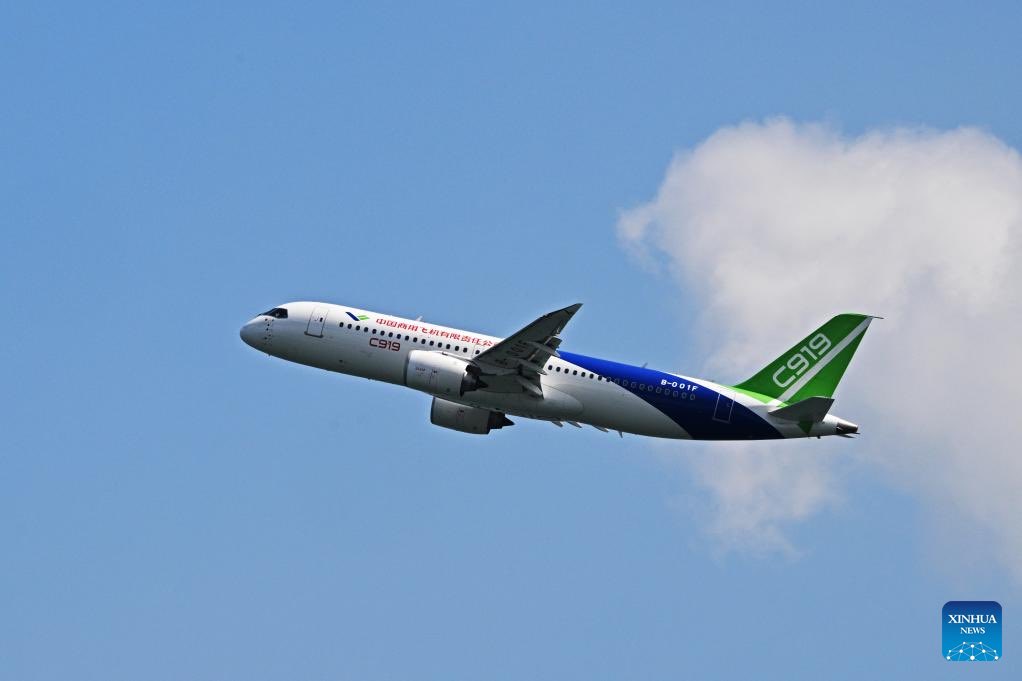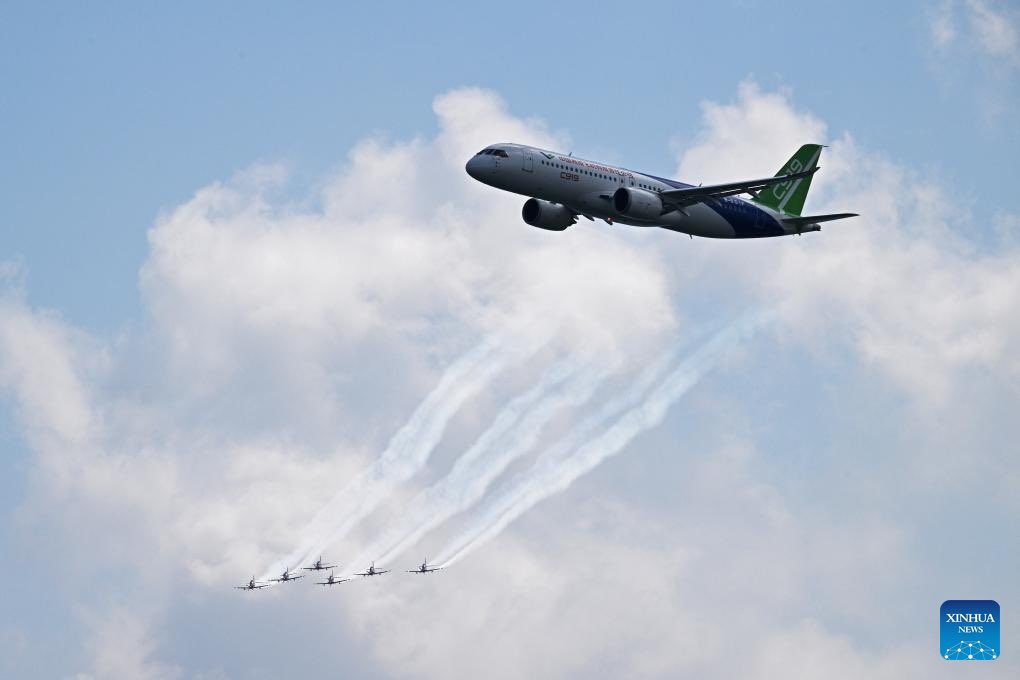China’s ambition to challenge aviation giants Airbus and Boeing took a major leap forward as the C919 passenger aircraft, manufactured by the Commercial Aircraft Corporation of China (COMAC), is set to make its debut outside Chinese territory at the Singapore Airshow 2024, scheduled to take place from February 20 to 25, 2024.
Five planes from COMAC will be seen at the air show: two C919s and three ARJ21 regional jets.
The C919, which arrived at Singapore Changi International Airport on February 17, has garnered attention as it showcased its capabilities at one of Asia’s most prestigious aviation events.
The C919 was described by Brendan Sobie, founder of the Singapore-based aviation consultancy Sobie Aviation, as “kind of like a milestone, and it’s the storyline for the show.”
The showcasing of the C919 comes at the right time. Over the last couple of years, the international aviation industry has been going through a downturn despite the growth in air travel after COVID-19.
The C919’s maiden international outing points not only to aviation’s recovery but also to China’s impact on the international aviation market.

The aircraft took to the skies on February 18 for a rehearsal flight, ensuring it was ready to impress potential customers and industry observers alike.
The C919’s presence at the Singapore Airshow signifies China’s growing prominence in the global aviation market. Developed by COMAC, the C919 aims to compete directly with established players, Airbus and Boeing, in the narrow-body passenger jet segment.
During the rehearsal flight, the C919 was one of two commercial passenger aircraft that flew off Singapore’s coast besides Airbus, offering a glimpse of what China’s aviation industry has to offer.
Aviation aficionados from around the globe will be eagerly dissecting its performance, design, and potential sway over the worldwide aviation scene.
Meanwhile, Boeing has opted not to exhibit a commercial aircraft at this year’s Singapore Airshow 2024. The decision comes as China intensifies its investments to break free from the duopoly held by the leading Western plane manufacturers.
The C919’s developmental journey commenced in 2008, driven by China’s determination to establish its presence in the fiercely competitive commercial aircraft sector.
After years of meticulous development, the prototype was unveiled in 2015, followed by its inaugural flight two years later. In May 2023, the aircraft achieved another milestone by carrying its first passengers on a domestic route, officially launching its commercial service.
The C919 embarked on its inaugural flight outside mainland China to Hong Kong in December 2023.
With seating for 156 to 168 passengers and a range of up to 3,000 nautical miles, this narrow-body aircraft, according to the Chinese manufacturer, offers airlines versatility and efficiency for regional and short-haul routes.
In 2023, two C919 aircraft were handed over to commercial carriers, and aviation consultancy IBA predicts that between 7 and 10 C919s may be delivered in the year 2024.
Beyond its technical specifications, the C919 holds immense significance, symbolizing China’s increasing confidence in its aerospace capabilities.
Customers For C919 Aircraft
Crafted as Beijing’s response to the American Boeing 737 and the European Airbus A320 families, the aircraft is tailored to cater to both the Chinese domestic market and the rapidly expanding Asian market.
Chinese media pointed out that showcasing the C919 at the Singapore Airshow serves as a crucial opportunity to bolster confidence among international customers in the prowess of ‘Made in China’ aircraft.
It may be pointed out that with the production hurdles confronting both the European Union’s Airbus and the US’ Boeing – in fact, Boeing is going through a string of crises — COMAC stands poised to position itself as a compelling third alternative.
Reports from Chinese media in January quoted a COMAC official stating that the company planned to pour tens of billions of yuan into expanding C919 production capacity over the next 3-5 years.
The majority of orders for this aircraft have come from domestic airlines, with China Eastern Airlines leading the way. As the world’s first operator of the C919 in 2021, China Eastern Airlines initially ordered five units of the aircraft.
Chinese experts said exploring overseas market and promoting the plane to more international airlines is a test for the C919 manufacturer, and the display of the C919 at the Singapore airshow will allow more international customers to increase their confidence in Made in China… pic.twitter.com/QCfieAOIrN
— Global Times (@globaltimesnews) February 17, 2024
In 2023, the airline further solidified its commitment to the C919 by signing a contract with the Commercial Aircraft Corporation of China (COMAC) to purchase an additional 100 units of the passenger plane. This significant investment underscores China Eastern Airlines’ confidence in the C919’s capabilities.
Currently, the airline is operating four domestically manufactured C919 aircraft. Another major Chinese carrier, Air China, has also entered the fold by securing a contract to acquire six C919 planes. The deliveries of these aircraft are scheduled between 2024 and 2025.
Last year, GallopAir, a fledgling airline based in Brunei, announced its intentions to procure 15 C919 aircraft. This announcement potentially heralded the first overseas acquisitions of the narrow-body C919 jet.
Additionally, the C919 could offer Beijing an opportunity to revitalize the aviation industries of countries like Iran, Russia, and North Korea. These friendly nations could emerge as potential customers for Chinese aircraft.
Russia’s civil aviation sector has been significantly impacted by sanctions, no-fly zones, and aircraft impoundments following the invasion of Ukraine.

Similarly, Iran’s commercial aviation sector has faced challenges due to years of conflict, inadequate infrastructure, neglect, and underinvestment. International sanctions have further exacerbated the situation, making it exceedingly difficult to procure aircraft parts, let alone new aircraft.
Likewise, North Korea confronts similar obstacles, with its leader Kim Jong Un resorting to borrowing an American-made Air China Boeing 747 for travel to Singapore during the Trump-Kim summit in June 2018.
A major hurdle for the sale of the aircraft outside China is its certification. Granted only by Chinese regulators, the certification raises concerns about its acceptance and compliance with international aviation standards beyond China’s regulatory framework.
- Contact the author at ashishmichel(at)gmail.com
- Follow EurAsian Times on Google News




